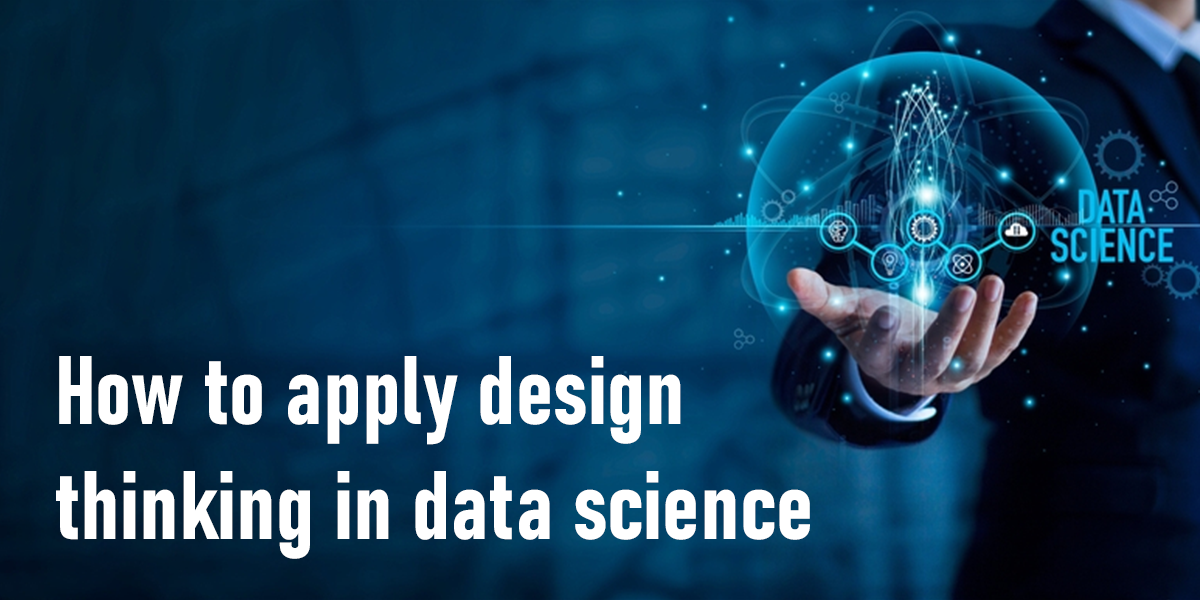How to apply design thinking in data science

Data Analyst
Experienced data analyst working with data visualization, cloud computing and ETL solutions.
Janaury 03, 2024

Applying Design Thinking in Data Science: A Comprehensive Guide for Innovation and User-Centric Solutions
In the rapidly evolving landscape of data science, where technological advancements and user expectations intersect, the integration of design thinking principles can pave the way for transformative and user-centric solutions. Design thinking, with its emphasis on empathy, ideation, prototyping, and testing, offers a holistic framework that goes beyond technical problem-solving to address the human aspect of data science. In this detailed exploration, we will delve into each stage of the data science process and elucidate how design thinking can be seamlessly applied, fostering innovation and ensuring that the end-users' needs are at the core of analytical solutions.
1. Understanding the Problem Domain: The Foundation of Empathy
The design thinking process commences with empathy, a foundational step that involves gaining a deep understanding of the people for whom you are solving problems. In the context of data science, this means immersing oneself in the problem domain to comprehend the challenges faced by end-users, stakeholders, and domain experts.
Conducting user interviews, surveys, and observational studies allows data scientists to gather insights into the nuances of the problem. By interacting with and observing users in their natural environment, data scientists can uncover latent needs and pain points that might not be apparent through quantitative data alone.
Creating user personas and empathy maps is a pivotal part of this stage. User personas serve as archetypal representations of different user segments, encapsulating their goals, behaviors, and pain points. Empathy maps, on the other hand, visually represent what users see, hear, think, and feel. These artifacts provide a tangible foundation for understanding user experiences and ensure that subsequent data science efforts are rooted in the real-world context of the problem.
2. Defining the Problem: Precision through User-Centric Framing
Once a deep understanding of the problem domain is established, the next step is to define the problem with precision and clarity. Design thinking encourages framing challenges from the user's perspective, ensuring that the problem definitions are rooted in the real experiences and needs of the users.
User journey maps, which illustrate the step-by-step experiences of users as they interact with a product or service, become instrumental in refining problem statements. These maps help identify pain points and moments of delight throughout the user journey, guiding data scientists to focus on areas that have the most significant impact on user satisfaction.
By framing problems in a user-centric manner, data scientists ensure that their analytical efforts are aligned with the actual needs and experiences of the stakeholders. This user-focused approach not only instills a sense of purpose but also ensures that the data science solution addresses the core issues faced by end-users.
3. Ideation: Fostering Creativity for Innovative Solutions
Ideation is a pivotal phase in the design thinking process, where creative solutions are generated collaboratively. In the realm of data science, ideation sessions bring together a diverse group of participants, including data scientists, domain experts, and designers. The goal is to brainstorm and explore potential solutions from various perspectives.
Techniques such as mind mapping, brainstorming, and reverse ideation are employed to encourage creative thinking. Mind mapping helps in visually organizing ideas and their relationships, while brainstorming sessions provide a platform for open-ended exploration of possibilities. Reverse ideation challenges participants to think about ways to exacerbate the problem, leading to innovative solutions by considering the opposite of conventional thinking.
Ideation in data science extends beyond just algorithmic innovations. It encompasses creative thinking about how data insights will be presented, interpreted, and acted upon. This holistic approach ensures that creativity permeates every aspect of the data science solution, fostering innovation and unique problem-solving.
4. Prototyping: Iterative Development for Rapid Progress
Prototyping is a critical phase in design thinking, where tangible representations of solutions are created for quick validation and feedback. In data science, this translates to the rapid development of models, dashboards, or analytical solutions that can be tested and refined iteratively.
Unlike traditional approaches that defer showcasing results until the end of the project, prototyping in data science allows for continuous feedback loops. By involving stakeholders early and often, data scientists can refine their models, visualizations, and approaches based on real-world feedback. This iterative and collaborative process ensures that the final data science solution not only meets user expectations but also adapts to evolving insights throughout the development process.
The iterative nature of prototyping aligns seamlessly with the agile methodology often employed in data science projects. This agile approach ensures that the development cycle is accelerated, and the end-users have an active role in shaping the final solution.
5. Testing: Validating Solutions for Real-World Impact
Testing in design thinking involves gathering feedback on prototypes and refining solutions based on user responses. In the data science context, testing equates to the validation of predictive models, assessment of dashboard usability, and confirmation of the relevance of generated insights.
Actively involving end-users in the testing phase ensures that the data solution meets their needs and effectively addresses the defined problem. Techniques such as A/B testing, user testing sessions, and feedback loops are integral to the testing phase, allowing for rigorous validation of assumptions and continuous refinement of the data solution.
The user-centric approach to testing ensures that the analytical outputs are not only accurate but also resonate with the end-users. It fosters a sense of ownership and trust, as stakeholders see their input directly influencing the final data science solution.
6. Implementation: Integrating Solutions Seamlessly
The implementation phase marks the transition from prototype to a fully operational data science solution. In design thinking, this phase emphasizes not only the technical deployment of models but also the seamless integration of analytics into existing business processes.
Ensuring a positive end-to-end user experience becomes paramount during implementation. The data solution should align with the workflows and daily operations of stakeholders. This involves not only the deployment of models but also considerations for user interfaces, data visualization, and communication of insights.
User training and documentation become integral components of the implementation phase. Clear documentation ensures that end-users understand how to interact with the data solution and leverage its capabilities effectively. The implementation phase aims to facilitate user adoption and ensure that the benefits of the data science solution are realized to their fullest extent.
7. Post-Implementation: Continuous Improvement and Evolution
Design thinking promotes a culture of continuous improvement and evolution, and this ethos extends into the post-implementation phase of data science projects. Establishing mechanisms for ongoing monitoring and feedback is crucial.
Analytics are employed to track the performance of models, and user feedback is actively solicited to adapt the solution to changing business or user needs. This iterative feedback loop ensures that the data science solution remains relevant, impactful, and continuously aligned with the evolving requirements of the organization.
The commitment to improvement after deployment is a distinctive feature of the design thinking approach. It acknowledges that the data science landscape is dynamic, and solutions must evolve with the changing needs of the business and end-users.
Challenges and Considerations in Applying Design Thinking to Data Science:
While the integration of design thinking into data science is powerful, it comes with its set of challenges and considerations:
1. Cross-Disciplinary Collaboration:
Ensuring effective collaboration between data scientists, domain experts, and designers requires breaking down silos and fostering an environment where diverse perspectives are valued. Communication barriers between these disciplines must be addressed to encourage collaborative problem-solving.
2. Data Quality and Ethics:
The responsible use of data, including considerations of data quality and ethical implications, must be embedded throughout the design thinking process. Data scientists need to be vigilant about the sources and quality of data to maintain the trustworthiness of the data science solution.
3. Iterative Nature:
Organizations must embrace the iterative nature of both design thinking and data science. This requires recognizing that insights evolve, and models require continuous refinement. This iterative approach may clash with traditional, linear project management methodologies, necessitating a shift in organizational mindset.
4. User-Centric Focus:
Maintaining a strong user-centric focus necessitates ongoing engagement with end-users. This goes beyond initial user research and testing to ensure that the data solution remains aligned with their evolving needs. It may require organizational efforts to cultivate a user-centric culture.
5. Communication and Visualization:
Effective communication of findings and insights, using visualizations and storytelling techniques, is crucial for making complex data accessible to a non-technical audience. Clear communication is vital for gaining organizational support and ensuring that data-driven insights are understood and acted upon.
Conclusion:
In conclusion, the integration of design thinking into data science represents a strategic approach that fosters innovation and ensures that solutions are deeply rooted in user needs. By prioritizing empathy, ideation, prototyping, and testing, organizations can create data-driven solutions that not only solve technical challenges but also resonate with the needs and experiences of end-users.
As organizations navigate the complexities of data science, the marriage of design thinking principles with analytical rigor sets the stage for a transformative and deeply impactful data science practice. The iterative and user-centric approach advocated by design thinking ensures that data solutions evolve with the changing landscape, remaining relevant and aligned with the ever-evolving needs of the business and its users. This comprehensive guide provides a roadmap for data scientists and organizations looking to integrate design thinking seamlessly into their data science processes, fostering a culture of innovation and user-centric problem-solving.













